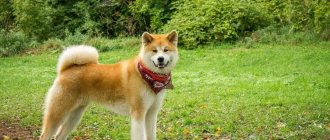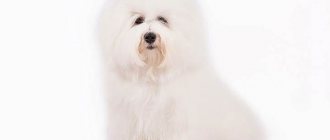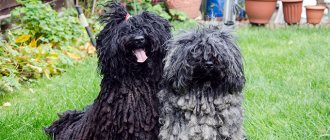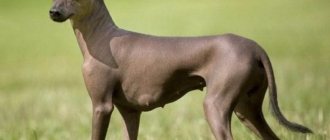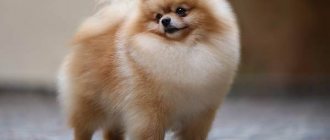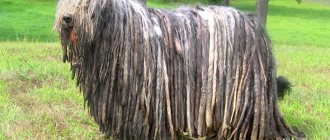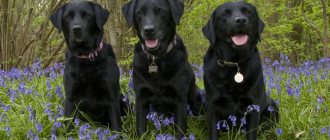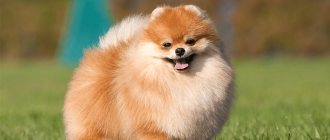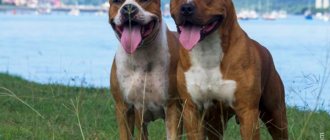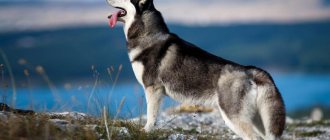The most commonly found Japanese dog breeds on the streets and in city parks are the Japanese Chin, while the most frequently mentioned in the media is the Akita Inu. The latter became famous because back in 2012, the governor of Akita Prefecture presented the President of the Russian Federation with a puppy of this breed, thereby expressing gratitude for the assistance provided to Japan. Putin, in turn, presented the governor with a huge fluffy cat.
The most commonly found Japanese dog breed on the streets and in city parks is the Japanese Chin, and the most frequently mentioned in the media is the Akita Inu.
In addition to these two, Japanese dog breeds include more than 10 species that are quite rare in Europe and the USA. They all have common characteristics: the ears are small and erect, the tail is curled, the eyes are slightly slanted, and the shape of the head is wedge-shaped. According to the canine rules existing in the world (FCI standards), the country that has entered the breed into the international register has the right to call it its own.
Japanese Chin
We should start the review with the most charming Japanese dog, which has long taken a place in the hearts of a large number of people. We are talking about the Japanese Chin. This little dog is so cute, active and playful that it simply has no equal among miniature pets. Only the Pekingese could compete with her, but his short legs and heavy landing simply do not allow him to catch up with the perky, self-confident and light little one.
The Japanese Chin is filled with a sense of self-importance and wants to be the center of everyone's attention, so it becomes very upset if its own attention is rejected. For more than 1000 years, chins belonged only to the imperial family, being royal favorites. One of the emperors even ordered them to be worshiped, declaring the dogs sacred. They had their own servants and doctors, and only members of the imperial family could own them. Especially miniature specimens were kept in cages, in a suspended state. A pair of Chins was given to Queen Victoria in 1853, which influenced the further development of the breed.
The Japanese Chin is unusually graceful, with a proud posture and luxurious coat. The coat color can be white with either black spots or red markings. The more distinct and brighter the red color, the better it is considered. The spots on the head and ears should be placed symmetrically relative to each other. Some believe that chins are descendants of a lion and a butterfly: they really look like a lion with their muzzles and are mobile, fluttering like butterflies.
Weight by month
The FCI standard does not have exact weight standards for Shiba Inu. Nippo's description states that adult males should weigh 10-13 kg, females - 7-9 kg.
Therefore, there are no specific weight indicators for the development of a puppy by month. They focus on the overall harmony of the addition and adhere to the following approximate standards:
| Age | Weight |
| At birth | 300–400 g |
| 1 month | 0.7–1.0 kg |
| 2 months | 2–3 kg |
| 3 months | 3.5–4 kg |
| 4 months | 4.5–5 kg |
| 5 months | 5–6 kg |
| 6 months | 5.5–8 kg |
| 7 months | 6–9 kg |
| 8 months | 6.5–9.5 kg |
| 9 months | 7–10 kg |
Gallery: Japanese dog breeds (25 photos)
Hokkaido
For his Hokkaidos, a loyal protector, affectionate and playful friend. May show aggression towards strangers and animals
Classification Class: according to the FCI classification - 5th group (northern sled dogs, spitz, primitive). Section 5.261 (Asian Spitz and related breeds, Hokkaido).
Use: for hunting.
Color: gray, red, brindle, white, brown.
Dimensions: height at withers: males - up to 53 cm, females - up to 50 cm weight: males - up to 25 kg, females - up to 22 kg
Lifespan: 11-14 years
The Hokkaido breed was bred for hunting, like the West Siberian or Karelian-Finnish Laika . Otherwise it is called Ainu.
The dog’s character was also nurtured for a long time so that it would become brave, loyal, fierce and sensitive.
For his Hokkaidos, he is a loyal protector, affectionate and playful. May show aggression towards strangers and animals.
A person of strong character will be able to cope with it, since the pet’s temperament is complex. It is better to keep the dog in an enclosure.
Brush as needed. Long walks are needed to develop muscles.
The Hokkaido breed was bred for hunting. This is a brave, loyal, fierce and sensitive dog.
Japanese Akita
The second most important and popular breed, and maybe even the first, is the character from the Hollywood film “Hachiko”, based on real events. Shocked by the devotion and love for his owner shown by the Akito Inu dog, who waited for him for all 8 years until his death, the Americans wanted the same devoted friends to live in their homes. Residents of the United States, through targeted crossbreeding with larger dogs, even developed the American Akita, or Big Akita, breed, which, at the request of the Japanese side, was separated into a separate category in 1988.
Japanese Akita is one of the most famous Japanese Spitz breeds. It was once bred to hunt wild animals, so to this day a dog of this breed is capable of a fierce attack and formidable defense. Based on these qualities, the dog is used mainly for protection. The dog is easy to train and has an even temperament. Akito Inu is affectionate with the whole family, although he is a reserved and proud dog, absolutely fearless. It has small membranes between its toes, which allows the dog to swim well.
Today, Japanese Akita serves as a symbol of Japan, and its figurine, received as a gift, is considered to bring happiness and health.
Care and maintenance
Caring for a clean and unpretentious chin is absolutely simple. It is advisable, of course, to take him for a walk three times a day, but it is permissible to limit himself to one walk, having accustomed the dog to a home litter box. In bad weather, you can walk with your dog, holding it in your arms, or dress your pet in a waterproof overall. During hot weather, it is advisable to walk your dog in the shade, as overheating may cause the dog to suffocate. For walks with your chin, choose not a collar, but a chest harness - a kind of harness, since its neck is quite delicate. Please note that these dogs, being without a leash, can easily climb the first height they come across, for example a children's slide, so you need to make sure that the little pet does not fall and injure itself.
Japanese Chin with Yorkshire
Caring for the coat of the Japanese Chin is also not difficult. He does not need model hairstyles, and the haircut is only hygienic, requiring only the removal of overgrown hairs. It would be good to brush your pet daily; in any case, this procedure should be performed at least twice a week, accustoming the dog to it from puppyhood.
Cinchona is bathed as needed, but not more than once every two weeks. Paws and ears are washed as they become dirty. For bathing, use zoo shampoos, which, in addition to the cleaning effect, also have antimicrobial and antiparasitic properties. After washing with shampoo, treat the dog's coat with conditioner - this will make it fluff up and smell nice. After the procedure, the Japanese Chin must be dried so that it does not catch a cold. You can use a towel or hairdryer.
As an alternative to bathing, you can use a dry method of cleaning the animal's fur using a special powder. Some owners use talc or baby powder for this procedure. The product should be carefully rubbed into the pet’s fur, making sure that some of it gets on his skin. After powdering, thoroughly comb the animal's fur until the powder disappears completely. This method allows you to effectively clean the coat of dirt and dead hair.
Grooming of the Japanese Chin
The claws of Japanese Chins grow very quickly, while they bend and split, which causes discomfort to the dog. They should be trimmed using a nail clipper as they grow, usually at least once a month. The dog will be especially grateful to the owner for this cosmetic procedure.
The diet of chins should be high in calories. These dogs don’t eat much, but they move very actively, even when living in an apartment. The diet should include foods containing sufficient amounts of protein and calcium. For animals of this breed, the following products are preferred and must be alternated: turkey meat, chicken, lean beef, boiled liver, tripe, kidneys, sea fish (no more than once a week), boiled yolk (two to three times a week). Periodically you need to give rice, boiled vegetables, raw pitted fruits.
The finished food must be premium or holistic.
It is important not to overfeed your chin, because it quickly gains excess weight, and this negatively affects its health. It is advisable that the gentle Japanese Chin be periodically examined by a veterinarian for preventative purposes. For animals of advanced age, veterinary examinations are recommended to be carried out regularly.
For animals of advanced age, veterinary examinations are recommended to be carried out regularly.
It is advisable that the gentle Japanese Chin be periodically examined by a veterinarian for preventative purposes. For older animals, veterinary examinations are recommended regularly.
Japanese Chin after shower
Shikoku, or Shikoku
The name of this breed is translated differently, so in the literature you can find references to Shikoku and Shikoku. But this is the same very rare Japanese Shikoku breed, which is little known in foreign countries. The hunting dog that is Shikoku has been known in the land of the rising sun since ancient times, and under a variety of names. Its other names: Kochi-ken, Kochi-inu, Kochi-ken, Mikawa-inu. It was originally used for hunting large animals such as wild boar or deer.
Shikoku is slightly similar to a wolf: it is also hardy, always alert and requires enormous loads and great willpower from its owner. It is not recommended for beginners to own one, and there is no place for it in the city either. It is suitable for people from the suburbs. Shikoku was named a Japanese Natural Monument in 1937.
American Akita
This breed is not recognized by all canine organizations in Japan as a native breed. But the roots of the American Akita go far back in history. These dogs were used not only as hunting dogs, but also as herding dogs. These animals are distinguished by strong devotion to their owners. They have a pronounced dominant temperament. Proper training develops in them qualities that allow them to be patient with children. The American Akita can weigh up to 50 kg.
Akitas practically do not get along with other animals, as they see them as potential prey. Representatives of this breed love to chase other animals. Such dogs require a proper and well-thought-out training system. They do not like monotonous and monotonous activities. Otherwise, the American Akita begins to experience a lack of activity.
It is worth considering that these dogs have a heavy skeleton. Therefore, you cannot load the dog until the formation of the musculoskeletal system is completed.
Kishu, or Kishu
Kishu is an aboriginal hunting dog that appeared on its own without human intervention, on the hills of Kishu Island, where its name comes from. Its color is usually white, monochromatic, although red, brindle or sesame are also found. The character is calm. Kishu is silent and does not bark over trifles, although she is vigilant and distrustful of strangers. Due to all these qualities, it is perfect as a watchman and security guard.
Kishu can be kept in the city if you remember that the dog needs activity and physical exercise, for example, participating in bicycle rides with the owner. If the right conditions are created for her, she will faithfully serve her owner for many years.
Shiba Inu
These animals are highly disciplined and have the ability to learn. They easily interact with other pets, but they perceive birds as prey. They need early socialization. Due to its pronounced independence, the right approach needs to be found for this breed. This breed is loyal to its owner, but strives to defend leadership.
It takes a lot of time, effort and attention to train and educate. The desired results can only be achieved without the use of force. Shiba Inus are easy to train. A dog can live not only in an enclosure, but also in an apartment, but it must be taken into account that the animal needs frequent physical activity.
Sanshu Dog
The Japanese dog Sanshu is a breed of service dog. She was brought out purposefully, wanting to get a small animal for guard duty. The result was a strong, beautiful dog that weighs about 20 kg. Due to its small size and weight, as well as its excellent watchdog qualities, Sanshu can be kept both outside the city and in city apartments.
The color of the animal can be very different, the coat is short and does not require special care. The body is proportional, strong and healthy. Sanshu is perfect to become a companion not only to one, but to all family members. She gets along with other animals in the house and gets along easily with small children. Sanshu has no hunting skills, which guarantees her peaceful interaction even with cats.
Akita Inu
The Japanese Laika belongs to the Spitz group and is the largest of them. Previously, they were called “matagi,” which literally means “bugbear.” This is due to the fact that the animal was originally used to lure large animals during hunting. The breed was bred in an area called Akita, which is known for harsh climatic conditions.
The breed has a distinctive appearance: a large head and triangular-shaped eye sockets. The body of these animals is well developed. Akitas cannot bark for long periods of time, but they are capable of making various snorting sounds.
Akita is well adapted to being kept in a variety of conditions. The abundant coat of wool prevents the breed from freezing even in severe winter. The breed does not require much effort in care; it is enough to comb the coat several times a week and bathe it when necessary. These dogs have an easy-going disposition. They are patient and loyal to children. Their calm temperament makes them ideal animals for people exposed to frequent stress.
Kai Dog or Kai Inu
The Kai Inu has many names, including the Tiger Dog. The breed is aboriginal, which for a long time was generally considered a mongrel. Today it is spoken of as a classic Japanese breed of hunting dog. Kai Inu is of medium height, weighing about 20 kg, with a strong body and well-developed muscles, short coat, mostly brindle in color: stripes on a red, black or motley background.
The dog is independent, independent, devoted to only 1 person and obeys only him. Has a tendency to dominate in relationships with humans, so it needs strict training. Although the dog is not aggressive and is adequate in the presence of strangers, it is recommended to keep him outside the city, especially since he needs a lot of physical activity. Interestingly, Kai Inu can climb trees, and quite well.
Tosa Inu
In Japan, mastiffs were bred as fighting animals. Local dogs were crossed with European dogs to enhance certain characteristics. These animals are not suitable for novice dog breeders due to their stubbornness and developed strong-willed qualities. The breed has increased aggressiveness. Good training will make a mastiff an excellent companion and watchman.
Mastiffs reach a weight of 100 kg. They have a massive head, floppy ears and well-developed muscles. It is important to start raising puppies of this breed in the first months. Dogs of this breed have a hard time living in an apartment. They are contraindicated for families with children and other pets. The severe mastiff tolerates only its owner on its territory.
Representatives of the breed require long walks and exercise. With their deficiency, the dog begins to show unmotivated aggression.
Sakhalin Husky
The Sakhalin Husky, called the Karafuto-Ken by the Japanese, is considered an endangered breed that survives today in small numbers only in Japan. It was once bred in Russia to transport goods, so the dog is strong, large and very independent. She has a calm character, good health and great stamina.
Although the husky first appeared in Russia, where it was called the Sakhalin Laika, the breed is currently under the patronage of Japan. Gone are the days when local tribes used it to bait bears, and today the Husky is a beautiful and balanced animal, very loyal to its owner. During the Second World War, these huskies were considered the best for military service on the eastern outskirts of the country.
Sanshu
The Sanshu is another ancient Japanese dog breed that was brought back to life by enthusiasts in the early 20th century. His ancestors accompanied the emperors, protecting their lives and protecting their peace. And pets today are excellent guardians, faithful companions and loyal family members.
The Sanshu is a rare breed that is almost impossible to find outside of Japan. Moreover, it has not yet been recognized by major canine organizations.
Sanshu are distinguished by their medium size (41-46 cm and 20-25 kg), a fox-like muzzle, triangular ears and a tail thrown over the back. The color comes in a variety of colors: white, red, brown, tan, black back, gray or pepper and salt.
Sanshu are unpretentious. They can live in a house or apartment, and hygiene procedures require periodic brushing, bathing, and examination of ears and teeth. The main thing is to pay attention to nutrition and disease prevention. If you take good care of your pets, they will live to be 15-17 years old.
Ainu Dog or Hokkaido Dog
Hokkaido, or Ainu, Ainu-ken, Seta, Shita, also participated in the Second World War, but on the side of the Japanese. Used to transmit information and search for enemy camps. Like Shikoku, it was declared a Japanese natural monument in 1937. The ancestors of Ainu were dogs that participated with the Ainu tribes in hunting bears and other large animals.
Hokkaido have retained all their hunting animal instincts, which causes them to have a rather cruel disposition with a very cute appearance. Ainu does not tolerate other animals and strangers, and in addition, he constantly fights for power with anyone who claims it. Therefore, keeping such animals in a city apartment or large family is not recommended.
Other breeds worth mentioning include the Japanese Spitz, Japanese Terrier, Ryukyu, Jomon Shiba, Shiba Inu and Tosa Inu. But we can talk about them next time.
Jomon-shiba
The breed is very popular in Japan, but it has not become as widespread in other countries. The ancestors of the Jomon Shibs are ancient dogs that lived in mountainous areas. They have been domesticated and live as pets for humans for about a thousand years.
The Jomon Shiba is not approved by canine societies in Japan, but there are a large number of lovers of these dogs. In fact, this is a slightly modified wild dog, which in appearance, habits and disposition strongly resembles the Japanese wolf.
This breed retains all the features characteristic of primitive animals. They have a strong hunting skill, they are distinguished by courage and independence. For this reason, training must begin at an early age.
Origin story
For centuries, the dog has played a vital role in the lives of people in Kamchatka. It was the only hunting and transport animal, and largely determined the possibility of existence and settlement.
According to the 1926 census. There were 50,000 sled dogs in the Kamchatka and Anadyr regions. In the post-war years, they were systematically destroyed in order to save fish, but until the 50-60s, their numbers were still relatively large. By the end of the 80s there were almost no purebred Kamchatka dogs left. Many were displaced by technological progress, while others were mixed with other breeds.
Currently, the breed is being intensively revived thanks to the work of Kamchatka mushers who annually participate in the Beringia sled dog races.
The first Beringia race took place in 1990. Then they sounded the alarm - there were very few purebred Kamchatka dogs in the sleds. Mostly these were various crosses. At the Beringia-91 and Beringia-92 races, an even greater deterioration in the breed was noted. It was then that the first serious measures were taken. In 1992, a standard was developed and recognized in service dog breeding of the Russian Federation. Kennels began to open, but the problem of reviving the Kamchatka sled dog remains relevant to this day. Sometimes you have to look for fresh blood even among Alaskan huskies, which, according to some sources, are direct descendants of Kamchatka dogs. The breed was significantly improved, but many characteristics were lost.
Japanese Terrier (Nihon Terrier, Mikado Terrier, Oyuki Terrier)
- The official name is Japanese Terrier.
- FCI classification – group 3, section 2, standard No. 259.
- Origin and patronage - Japan.
- Dimensions: 30–33 cm.
The terrier is a hunting dog that works in a hole. A breed with an unexpected appearance for Japanese breeds - short-haired, with semi-erect ears and an elongated set. In Japan, burrow hunting was not developed, but terriers brought by Dutch traders aroused the interest of Japanese breeders. Having decided to create their own breed, with the appearance of a terrier and the disposition of a companion, the breeders mixed the blood of Italian Greyhounds, Pointers and Fox Terriers with imported hunting dogs. It is unknown whether Japanese breeds participated in breeding work. The resulting Japanese terriers were not only recognized in their homeland, but also declared a national treasure.
This is interesting! The Japanese Terrier is the only breed that is allowed to be exported from the country, despite its status as a national treasure.
The breed is very rare in the world; in Europe there are less than a dozen dogs. Japanese terriers were originally bred as domestic dogs, even apartment dogs, so they have a lively disposition, but have almost lost their hunting skills. Tailed cats are very clean, short-haired, odorless and easy to care for - an ideal pet for a working owner. The only caveat concerns the activity of dogs; they need long walks and active leisure.
All the benefits of small dogs
The demand for pocket dogs is growing every year. Pets have a beneficial effect on the upbringing and development of children. Tiny creatures are devoted to those who care for them. Despite their size, they are lively and brave. We are always ready to defend ourselves if the owner is in danger.
Friendly, cheerful creatures lift your spirits. Looking at them, only positive emotions appear. Abroad they are considered four-legged doctors.
Positive creatures have an incredible healing effect on humans. Pets don't require a lot of space. They feel comfortable in a small living space, there are many positive aspects.
The main advantages of mini dogs:
Compact size. Despite his small height and weight, the pet has a big heart. Such a tiny animal will give its owner his love and become a full-fledged member of the family. No fear of heights. Fearless animals bypass their larger counterparts: they are not afraid of heights, and, it seems, are even ready to make a parachute jump.
They eat little. The small pet, although picky about food, eats little. They go to diapers. When there is no time to walk with her, she easily learns to go to the tray or diaper. They love affection. Few people would think of coddling a Great Dane or a Rottweiler.
With small dogs you can afford such familiarity. They love to be in the arms of their owner and are always happy when they are petted. Minimum dirt. There is little smell or fur in the home from a miniature dog.
Portability. The world's tiniest dogs fit in a purse. You can take it with you on a visit or to the store, or transport it in transport without any hassle. Long-lived. Such “babies” have a longer life expectancy than their larger relatives.
How to choose a puppy?
If you have weighed all the pros and cons and decided to get such an interesting four-legged companion, then you should know that you will need to choose him very carefully. For this, experts recommend contacting exclusively professional breeders. Before buying a purebred puppy, it is better to go directly to where the animals live and grow. It is advisable to look at the puppies' parents. The mother and father of purebred pets must have the following qualities:
compliance with all standard sizes established by standards (based on the sex of the animal, of course); The ears of the parents of the puppies must be pointed, triangular and firmly standing; it is very important to pay attention to the color of the coat of the producers - there should be no rejection, preferably it should be neat; The tail should be curled into a ring and there should be no creases.
The ideal genetic characteristics of the puppies' parents will determine the appearance and health of their offspring. If the bitch has already given birth to puppies before, then it is worth asking to see their photographs. This way, you can estimate what your pet will look like when it becomes an adult. A nice nice addition would be the participation of both parents in exhibitions.
It is very important to keep in mind that a family of purebred individuals should be kept by the breeder only at home. The process of socialization of puppies from the moment they are born will determine their disposition, character traits, ability to get along with people, and the ability to get along and play with children.
If an animal is raised in a regular enclosure, then, most likely, it will not be so easy to train and raise it in the future.
It is worth paying attention to the condition of the puppies themselves. Regardless of the purpose for which you are buying such a purebred dog, you should pay attention to certain characteristics and behavioral traits
A healthy puppy should have the following qualities:
be playful and active enough (the baby should not lie sadly in one corner, demonstrating weakness and powerlessness); the puppy must have absolutely clean eyes and teeth, as well as a tail and ears - be sure to pay attention to these areas; a purebred puppy must meet all established breed standards; a small Shiba Inu should not be afraid of other people and dogs (a child’s overly timid disposition is not the norm; it will be doubly difficult to socialize such an animal); The baby should not behave too aggressively and viciously.
If you want to get such a sweet and smart friend, then you should definitely take into account all the listed criteria for selecting a good and healthy puppy. Please note that excessive cowardice and anger are not typical qualities for a Shiba Inu. If a puppy has such character traits, then raising him in the future can create many unnecessary problems, and it will take a lot of time.
Education and training
The main thing in raising a Japanese Spitz is the ability to quickly establish emotional contact. If the dog loves the owner and trusts him, there will be no difficulties in training. And vice versa: if the “Japanese” failed to find his niche in the new family, even an experienced dog handler will not be able to turn him into an obedient companion. So as soon as your four-legged friend moves into your home, look for a special key to his heart, because then it will be too late.
Do not confuse warm, trusting relationships with connivance. Undoubtedly, the Japanese Spitz is sweet and charming, but in this world he is not allowed everything. And since punishments with these Asian cunning people do not work, try to put pressure on them with a serious tone and convincing demands. In particular, the dog must clearly understand that picking up any objects from the ground and accepting treats from strangers is taboo. By the way, do not expect that your pet will demonstrate standard obedience in all life situations without exception. The Japanese Spitz is too smart to enjoy the role of a blind performer: he agrees to be friends with you, but not to run for slippers and chips for “Your Majesty.”
The performance of the “Japanese” is phenomenal, which was clearly confirmed by Nikolai Pavlenko’s charges, so don’t be afraid to overwork your shaggy pupil. It’s worse if he loses interest in training, so include a good old game in the training process more often so that your little student doesn’t get bored. Typically, a two-month-old puppy is ready to respond to its name and knows how to use a diaper or litter box correctly. The third and fourth months of life are the period of familiarization with the rules of etiquette and the commands “Ugh!”, “Place!”, “Come to me!”. By six months, Japanese Spitz dogs become more diligent, they are already familiar with the street and understand what is expected of them. Consequently, this is the optimal time for mastering obedience commands (“Sit!”, “Near!”, “Lie down!”).
As for socialization, a principle common to all breeds works here: more often simulate situations that force the pet to adapt to changed environmental conditions. Take him for walks to busy places, arrange meetings with other dogs, ride on public transport. The more new unusual locations, the more useful it is for the “Japanese”.
